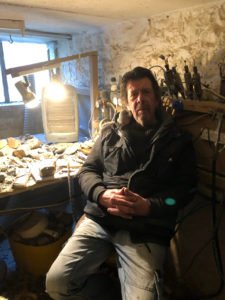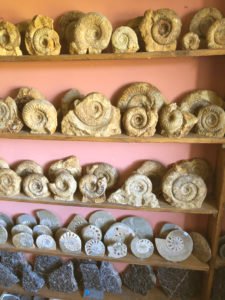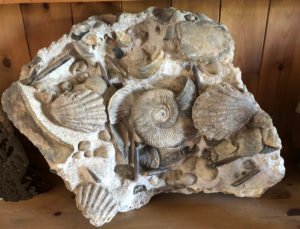Its strange, what makes a good summer for visitors is a disaster for fossil hunting. We have not had much rain and the Jurassic Cliffs are baked and hard with little movement. The good weather does have one bonus there have been dolphins seen just offshore and the dead body of a porpoise was washed up on the beach to the west of Charmouth. To the east of Lyme Regis there is a large amount of sand covering the best area to find fossils. The beach changes every day and a sudden storm or strong south westerly winds could change very thing over night.
I have been very busy and I have been unable to take out all those that would like to go on a fossil hunting trip and apologise for those disappointed.
From May17th Government Restrictions are lifted on group numbers.
On May 17th the government restrictions are lifted on group numbers which will make life a bit better!
Please note that the bookings are quickly filling up. Please book in advance as soon as possible to avoid disappointment.
Jurassic Spring 2020-The Plague.
Jurassic Spring Watch 2020.
This Easter has had the best weather for years with blue skies and a sea glistening like the Mediterranean. This could have been one of the busiest Easter’s ever, on the Jurassic Coast.
Unfortunately, in January in a small town in China a person was tempted by a nice meal of fried bats and noodles and managed to achieve in that one meal a world catastrophe of huge consequences.
How the dinosaurs must chuckle, at least their end had come from space where as mankind’s could come from a meal of bats.
The beaches are empty the shops are closed and I am in an enforced hibernation along with most of the world.
I am lucky; I live near the sea and take my exercise walks along the cliffs of the Jurassic Coast. The beach to the east of Charmouth, is still covered in sand deposited during the winter storms. The cliffs have had recent falls and there are accumulated mud and rocks at the base. On my slow walk along the beach there are plenty of belemnites and ammonites to pick up. On the beach are the tracks of an electric wheel chair. I do not know who this person is but I am amazed how far along he is able to drive.
At Charmouth, the Heritage Centre, Fossil shop and car parks are closed and it is very quiet. While at Lyme Regis the May Bank holiday Fossil Festival has been cancelled and in the town only the supermarket is open. We went for a walk round the Cobb (harbour) and we were the only people there.
The topping stone on the High Wall of the harbour was built from imported Portland Stone, in 1837. In the stone can be found ammonites (Titanites giganteus) and plenty of fossil bi-valves (Trigonia marariticea).
On Monmouth Beach (to the West of Lyme Regis) the winter storms have destroyed some of the “Ammonite Pavement” and frequently the limestone ledge of ammonites is covered in shingle.
It is strange to walk round a ghost town. The last time Lyme Regis was this quiet was in July 1348 when on 7th July a small cargo ship arrived at the harbour in Weymouth and introduced the first recorded case of the “Bubonic Plague” to Britain. I’m not sure how long their “lock-down” lasted!
(When my walks do resume please note they are not group walks but small individual family or for couples. I will address you with a loudhailerand keep a safe distance……..)
Nigel Clarke

“Well there is just the two of us!”
Peter Langham a finder of “Sea Dragons”.

Peter Langham in his workshop
at Charmouth
Charmouth Fossil Hunter Peter Langham.
In a small cottage on the outskirts of Charmouth, lives local palaeontologist Peter Langham.
Peter is a leading fossil hunter and has been collecting and cleaning Jurassic fossils for over
50 years. His knowledge of and his fossils finds are startling. In the basement of his cottage
is a studio workshop. At this well equipped studio and on every spare surface can be found
fossils and rocks awaiting the methodical and skilled cleaning undertaken by Peter. Each
fossil is laboriously chiselled out of the matrix of hard limestone. The fine details of the fossil
are carefully exposed by the use of tiny air chisels. A large fossil, such as an ichthyosaur, can
take months of careful work and will sometimes need acid etching, to improve the definition
of the find.

A collection of local Dorset ammonites
“Stephanoceras & Parkinsonia,
all cleaned and prepped by Peter
Peter is a dedicated and active fossil hunter. Included among his major discoveries are
several new species to science:
Ichthyosaur: (Kimmerosaurus lanhami)
Dinosaur: (Stokesisaurus langhami)
Dinosaur: (scelidosaurus). A plant eating dinosaur. The complete fossil was found on Black Ven and is an anomaly, as it is a terrestrial dinosaur, (which resembled a hippopotamus) found in a marine environment.
One of Peter’s best finds was a 2 meter long ichthyosaur, found in the ledges below the cliffs
of Black Ven, at Charmouth. This was a unique fossil and one which has a complete
embryo. The ichthyosaur is now on public display at Bristol City Museum.

A cleaned and prepared collection of fossils
found in this large nodule. Ammonites-Belemnites
Peter is a leading restorer and cleaner of fossils and has undertaken work for many of the
leading museums and collectors. In addition, Peter is a dealer and supplies to both
collectors and leading fossil retail establishments in many countries.
A Charmouth Fossil Hunter of Sea Dragons,





In a small cottage on the outskirts of Charmouth, lives local palaeontologist Peter Langham.
Peter is a leading fossil hunter and has been collecting and cleaning Jurassic fossils for over
50 years. His knowledge of and his fossils finds are startling. In the basement of his cottage
is a studio workshop. At this well equipped studio and on every spare surface can be found
fossils and rocks awaiting the methodical and skilled cleaning undertaken by Peter. Each
fossil is laboriously chiselled out of the matrix of hard limestone. The fine details of the fossil
are carefully exposed by the use of tiny air chisels. A large fossil, such as an ichthyosaur, can
take months of careful work and will sometimes need acid etching, to improve the definition
of the find.
Peter is a dedicated and active fossil hunter. Included among his major discoveries are
several new species to science:
Ichthyosaur: (Kimmerosaurus lanhami)
Dinosaur: (Stokesisaurus langhami)
Dinosaur: (scelidosaurus). A plant eating dinosaur. The complete fossil was found on Black Ven and is an anomaly, as it is a terrestrial dinosaur, (which resembled a hippopotamus) found in a marine environment.
One of Peter’s best finds was a 2 meter long ichthyosaur, found in the ledges below the cliffs
of Black Ven, at Charmouth. This was a unique fossil and one which has a complete
embryo. The ichthyosaur is now on public display at Bristol City Museum.
Peter is a leading restorer and cleaner of fossils and has undertaken work for many of the
leading museums and collectors. In addition, Peter is a dealer and supplies to both
collectors and leading fossil retail establishments in many countries.
A Wet and Bleak June….where has the sun gone.
Rain, rain, go away and come again another day and Royal Fish.
This time last year it was so hot but now the weather seems trapped in a spiral of rain, cloud and drizzle. I have been busy taken numerous groups out and although much of the area is covered in shingle and sand the best place to search for fossils is the beach to the east of Charmouth. There is a large mud slide developing about 1/2 mile to east of Charmouth and the other day a section of the cliff tumbled down onto the beach. The cliffs fall and crumble with-out warning and the area below the cliffs should be treated with respect.

On the beach at Charmouth, a dead dolphin was washed up onto the sand. The dolphin was in a state of decay. The Parish council lifted the remains of the dolphin with mechanical bucket and carefully moved it 200 metres further up the beach. I am not sure why, but it did attract a large crowd to watch this strange event.
A dolphin is designated Royal Fish and the finding of a dead one should be reported to the Crown (via the Coastguard Agency). Royal Fish included whales, dolphins and sturgeon. I think years ago such fish were a valuable commodity for their flesh and oil. To the best of my knowledge the Queen no longer consumes whales or dolphins. The similarity of the dolphin to that of an ichthyosaur is remarkable as both have evolved into this perfect shape as a fast moving marine predator.
A couple of months ago a, film company descended on the area, to make a new movie about Mary Anning. The Oscar winning actress Kate Winslet is cast as Mary Anning. There is not much known about Mary Anning’s personal life but in the film she is cast having a romantic entanglement with another woman. There is no record or historic evidence for this. I think it just a screen writer attaching a story line to a famous person. The story could be ascribed to any number of famous women and is slightly demeaning to the reason as why they are so important…but that’s just my personal opinion
Nigel
April-May Fossil Hunters Diary
May
Due to the upgrade work on my website, (making the site useable on mobile phones and
tablets) it has been a while since I have updated this blog. The weather is strange, a warm
Easter and recently a cold freezing May Day.
Over the last few weeks I have taken numerous groups fossil hunting. The beach is still
covered in a vast amount of shingle which has not shifted for months. I am always amazed
how much the structure and look of the beach changes with every tide. One day I can be
walking across a vast expanse of sand and two days later the tide, wind and sea have swept
away the sand. There is now a pebble and a beach strewn with a ridge of shingle stretching
along the high water mark. The best areas to find fossils along the Jurassic coast vary each
week.
To the west of Charmouth, there is a large snout of mud which for the last ten years has
been a great source of fossils such as belemnites, ammonites and even the occasional piece
of an ichthyosaur. Two years ago, after a southwest storm, the snout of mud was swept
away and a mass of shingle surged from the Lyme Regis side of the beach, completely
covering this area. The fossils are now buried below this mass of shingle and for the
moment nature has closed off this once productive area, until the next storm sweeps away
the covering of pebbles and stone.
To the west of Lyme Regis is Monmouth Beach where you can see the “Ammonite
Graveyard”. A ledge packed with remains of hundreds of ammonites. For many years this
area was fairly stable but in recent years, the winter storms have surged and a section of the
pavement has been destroyed. Further along the beach is a section of old stone workers’
railway track, which has been in situ since 1870 – much of this has now gone.
The moral of the story is: if you see a fossil on the beach save it because it will not last
forever!



